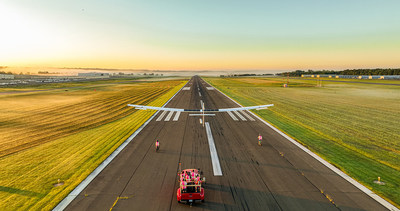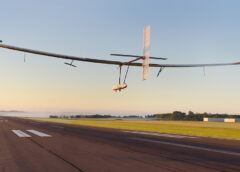mportant First Step Towards a New Climate Observatory System
MANASSAS, Va. /PRNewswire/ — Electra.aero, Inc. (“Electra”), a next-gen aerospace company with a mission to help decarbonize aviation and open new air transportation markets, announced today that it has completed the first flight of a solar-battery hybrid electric research aircraft. This 90-foot wingspan unmanned aircraft system (UAS) made its first flight from Manassas Regional Airport, Virginia on September 9, 2022, and is the first airplane to emerge from Electra’s new development facility there.
Electra’s “Dawn One” aircraft promises to dramatically expand our national climate research capabilities.Tweet this


The new plane, named Dawn One, is part of the Stratospheric Airborne Climate Observatory System (SACOS) program. SACOS is being developed under the leadership of Professor James G. Anderson at Harvard University. The project is supported by a contract from the National Aeronautics and Space Administration (NASA) and by the Weld Foundation for Scientific and Environmental Development.
“SACOS is designed to innovatively address a broad range of scientific missions and serve as a climate observing system that will herald a new era in the quantitative dissection of the physics, chemistry, and biology controlling critical climate systems. Following the lead of the new National Academy of Sciences report Global Change Research Needs and Opportunities for 2022-2031, SACOS promises to dramatically expand our national climate research capabilities,” said Professor Anderson.
“The high-spatial resolution observations from SACOS will provide, for the first time, quantitative forecasts of risk associated with rapidly expanding wildfires, the increasing rate of sea level rise, the intensification of severe storms, and global shifts in arid regions that trigger water shortages. Moreover, these quantitative forecasts of risk will, in turn, establish the essential intellectual links directly coupling irreversible changes in the climate structure to economics, public policy, and associated societal instability,” Professor Anderson explained.
The Dawn One project originated at the Massachusetts Institute of Technology (MIT) led by Professors John Hansman and Mark Drela. Detailed design, construction, and testing of the aircraft were led by Electra. This solar-battery aircraft is part of Electra’s ongoing development of reduced and zero-carbon aircraft propulsion technologies, which also include turbine-electric and hydrogen fuel cell-based hybrid systems.
The SACOS flight is part of the public celebration of the 2021 Dreyfus Prize in Chemical Sciences, to be presented to Professor Anderson on September 29, 2022 at Harvard. JP (James) Stewart of Electra and Annick DeWald of MIT led the aircraft team that included researchers and students from MIT, Harvard, Virginia Tech, Penn State, Stanford, Tuskegee, Embry Riddle, University of Michigan, San Diego State, and The University of Texas at El Paso.
Watch a video of the SACOS first flight HERE.
About Electra
Electra.aero, Inc. is a next-gen aerospace company leading the way in building aircraft for sustainable air transportation. Electra’s first commercial product is a clean, hybrid-electric, ultra-short takeoff and landing (eSTOL) airplane for urban and regional air mobility. Electra’s eSTOL will quietly fly people and cargo with greater payload, longer range, and significantly lower operating costs than comparably sized vertical takeoff alternatives. Electra is based in Virginia and has operations in Massachusetts and Switzerland.
SOURCE Electra Aero

Rod Washington: Rod is a blogger, writer, filmmaker, photographer, daydreamer who likes to cook. Rod produces and directs the web series, CUPIC: Diary of an Investigator. He also produces news and documentary video projects. Check out his podcast StoriesThisMoment at https://m3e.d71.myftpupload.com/stm-tncn-podcasts/


